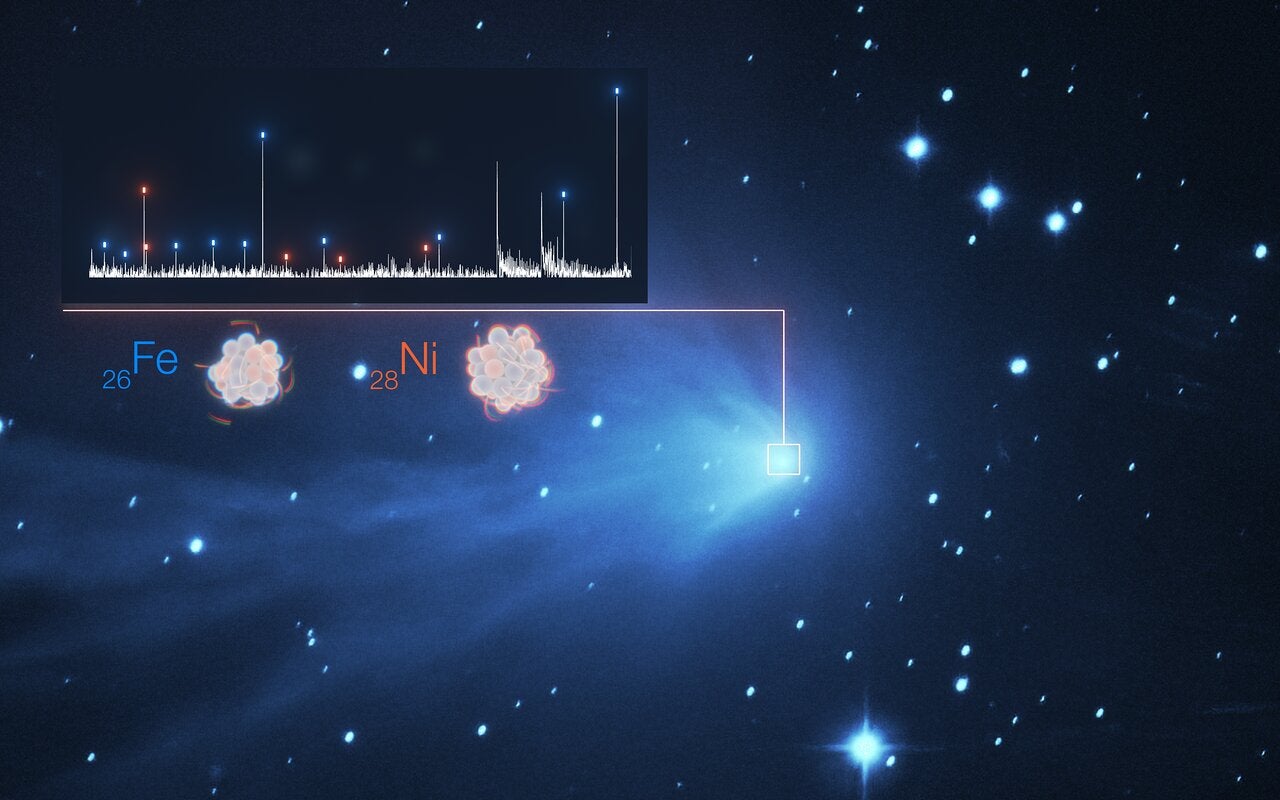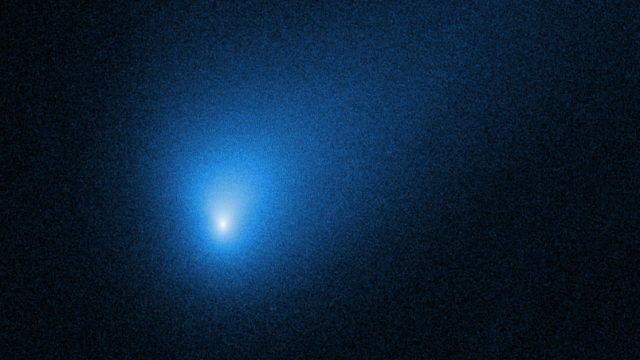Gaseous nickel was shedding from interstellar comet 2I/Borisov when it briefly visited our solar system two years ago, according to a new study. Sounds like weird behaviour for a comet, but as related research shows, the spewing of atomic metals might actually be a regular thing that comets do, whether they’re local or from across the Milky Way.
Two new papers, published in the journal Nature, are updating our understanding of comets, both in terms of their origins and the conditions under which they formed. Combined, the papers are allowing for an unprecedented comparative analysis, in which astronomers are contrasting local comets to one that formed far, far away.
We’re talking about interstellar comet 2I/Borisov, which visited our solar system in January 2020. Astronomers were able to identify its interstellar nature owing to its peculiar orbit. Recent research suggests Borisov is a fragment of a Pluto-like object, having formed in the Kuiper belt of its home star system. Borisov is often overshadowed by ‘Oumuamua — the first known interstellar object to visit our solar system (which it did in 2017) — but Borisov is equally deserving of attention, mostly because of the similarities it shares with native comets.
In the first of the two papers, a team led by Piotr Guzik from Jagiellonian University in Poland identified traces of nickel vapour in Boris’s cometary coma. His team “investigated the chemical composition” of the object and “noticed some signatures of emissions that, according to our best knowledge, were not known at that time,” Guzik explained in an email. “Our aim was to identify and quantify them.”
The team used data gathered by the Very Large Telescope in Chile, which allowed for a spectroscopic analysis of the comet. This technique allows scientists to study the chemical composition of celestial bodies, as the light of the target object can be split by a spectrograph, creating a colour spectrum from which specific atoms or molecules can be identified.
Comets are packed with primordial ice and dust that emerged when the planets were still coalescing. Water ice and other volatiles will sublimate (convert directly from a solid to a gas) even when a comet is far from the Sun, creating a ball of gas around the nucleus. As for pumping out gaseous nickel or other metals, that’s not something comets normally do — at least comets that keep their distance from the Sun.
“Nickel is a metal that sublimates only at high temperatures,” Guzik explained. “Therefore, though it is relatively common in the solar system and beyond, we did not expect to find it in the cold gases surrounding the cometary nucleus.”
Indeed, the detection of nickel vapour from Borisov was unexpected because the object was believed to be too cold to trigger the sublimation of metals, which requires temperatures in excess of 700 degrees Kelvin. This does happen, such as when comet Ikeya–Seki grazed the Sun in 1965 at “distances of approximately 30 and approximately 13 solar radii,” according to the paper. But Borisov didn’t go near the Sun (it got not no closer than 2.322 AU, or 347,618 km), and temperatures on the comet never exceeded an estimated 180 degrees Kelvin. The mechanism responsible for triggering the release of these metals on Borisov is something scientists now need to explain.
“The detection of the gaseous nickel in the cold gases surrounding the nucleus of a comet raises a question about its source,” said Guzik. “We found that the spatial distribution of the nickel atoms hints at some short-lived parent molecule. It would be interesting to detect it — possibly in the spectrum of some other, bright comet.”
Indeed, the second detection of an interstellar comet would be a big help, as it would allow astronomers to study its chemical composition and compare it with Borisov and comets native to our solar system.
“Every new and unexpected discovery in this field opens up new horizons for further research, because comets and asteroids are ‘time capsules’ containing information about the formation process of a planetary system that they originate from,” said Guzik. “Interstellar objects passing through our neighbourhood are the bridges between our Solar System and distant planetary systems which cannot be investigated [on site] because of huge distances in our galaxy. Therefore, the research on their chemical composition creates a context for understanding general principles of planetary systems’ formation in the Milky Way.”

In a related study, also in Nature, a team of researchers led by Jean Manfroid from the University of Liège in Belgium reported on the detection of atomic iron and atomic nickel in the spectra produced by comets native to our solar system. Using the Very Large Telescope, the team was able to calculate the rate at which these metals bleed out from the frigid cores of solar system comets. It’s not much — just one gram per second — but it’s a measurable amount nonetheless.
“Coincidentally, the amount of nickel produced per second is almost exactly the nickel content of a U.S. five-cent coin, or nickel,” explained Dennis Bodewits and Steven J. Bromley, astronomers at Auburn University who were not involved with the new study, in a related News & Views article.
Taken together, the two papers point to a common process of cometary origin. These shared chemical properties imply that native comets and Borisov formed under similar conditions and in similar places within their respective star systems. And as Bodewits and Bromley explain, should astronomers be able to “unravel the origin of iron and nickel in regular comets and this interstellar object,” they may “uncover a story of organic chemistry between shared different planetary systems.”
That other star systems experience processes similar to those observed in our own is not a monumental surprise, as the laws of physics are consistent throughout the universe. Still, it’s nice to have these suspicions bolstered by actual evidence. As these studies show, it’s now possible to study the chemical makeup of other star systems without actually having to actually go there.
